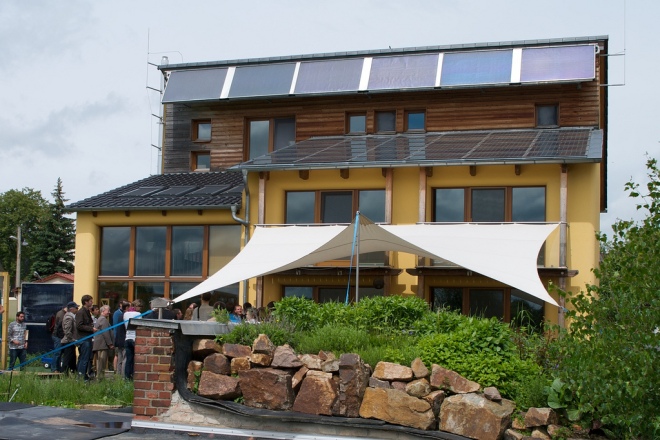A good short profile of the city of Freiburg, Germany, and their many sustainability initiatives. Freiburg is a little more than double Boulder’s size — both in population and area, so it has a similar average population density. It’s also a university town with a strong tech sector locally. The whole city was re-built post WWII, but they chose to build it along the same lines as the old city, with a dense core, and well defined boundaries. Today about half of daily trips are done by foot or on bike, with another 20% on public transit. They have a local energy efficiency finance program, on top of the national one administered by KfW, and higher building efficiency standards than Germany as a whole. Half their electricity comes from combined heat and power facilities that also provide district heating and hot water. It seems like they’d be a good model city to compare Boulder to, and learn from.
Tag: passive house
Passive Passion a short film about Germany’s Passivhaus Building Energy Efficiency Standard

Passive Passion is a good 20 minute long film introduction to the German Passivhaus energy efficiency standard, which reduces building energy use by 80-95% (depending on what existing code you compare it to). It looks at the roots of the design standard in Germany, and gives a few examples from the tens of thousands of Passivhaus certified buildings in Europe, including single family homes, row houses, apartment buildings, public low income housing, and office buildings. They talk about what makes the standard work: airtight building envelopes, super insulation, no thermal bridging, heat recovering ventilation. The film also looks at a few builders and designers in the US trying to popularize the cost effective implementation of these methods. It’s clearly possible. The examples are out there today. We just have to decide to do it! If we’re going to get to carbon zero, someday our buildings will all have to function something like this.
The film can be viewed online thanks to the enlightened self interest of Four Seven Five, a high performance building components supplier in New York.
Passive Passion
Passive Passion is a great 20 minute long documentary about the German Passive House energy efficiency standard. It looks at the roots of the design standard in Germany, and gives a bunch of examples of implementations in Europe, from single family homes to row houses, apartment buildings, public housing, office buildings, etc. Talks about what makes the standard work: airtight building envelopes, super insulation, no thermal bridging, heat recovering ventilation. Also looks at a few builders and designers in the US trying to popularize these methods, and do it cost effectively. Clearly it’s possible, we just have to decide to do it!
Empowerhouse: an affordable, net-zero Passivhaus in DC
The Empowerhouse is an affordable, net-zero Passivhaus design, that came out of the Solar Decathlon competition. In collaboration with Habitat for Humanity, the team as built a duplex in the Washington DC area that is site net-zero, despite having the smallest solar array of any of the homes entered in the competition. It was able to do this because it took a Passivhaus approach, aggressively minimizing all loads first, sealing the building nearly airtight, and super-insulating it. They also integrated a rooftop garden and terrace. By sharing the heat management equipment between the two relatively small units, they were able to reduce costs substantially. All this means the low income residents will spend much, much less on energy over the lifetime of the building. We need more affordable housing that looks like this.
An American Made All-in-one Thermal Appliance
Newell Instruments in Illinois has developed an all-in-one “magic box” heat management appliance, to compete with the ones currently manufactured in Europe, which are often prohibitively expensive in the US. The Newell CERV can both add and remove heat and humidity from a building and provide fresh air supply when needed. It can also be coupled with a heat-pump based hot water heater. Brought together in a super-insulated, airtight building this integration simplifies and increases the efficiency of space conditioning. Here’s hoping they can make it affordable too.